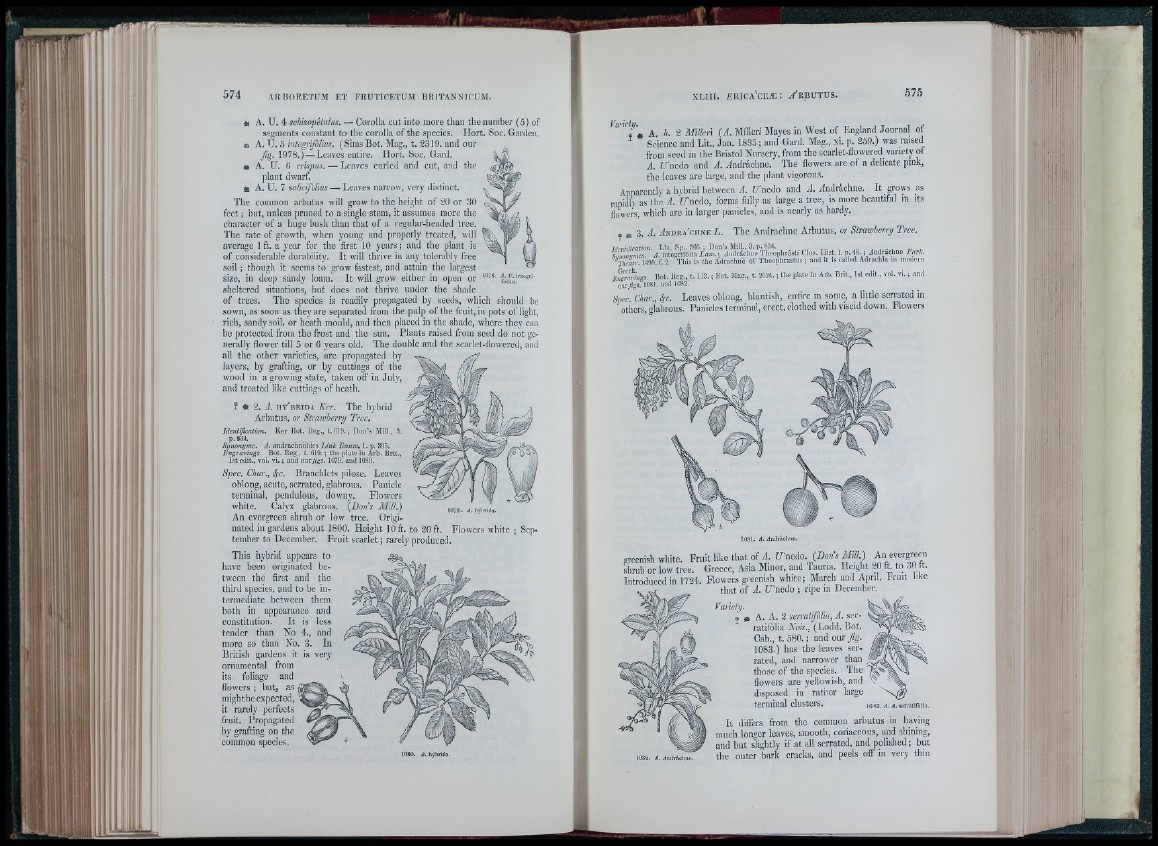
«* A. TJ. 4 schizopetalus. — Corolla cut into more than the number (5) of
segments constant to the corolla of the species. Hort. Soc. Garden.
fa A. U. 5 integrifdiius. (Sims Bot. Mag., t. 2319. and our
fig. 1978.) — Leaves entire. Hort. Soc. Gard.
« A. U. G crispus. — Leaves curled and cut, and tho
])lant dwarf.
tt A. U. 7 mlicifblius — Leaves narrow, very distinct.
The common arbutus will grow to the height of 20 or 30
fe e t; but, unless pruned to a single stem, it assumes more the
character o f a huge bush than that of a regular-headed tree.
The rate of growth, when young and properly treated, will
average 1 ft. a year for the first 10 years; and the plant is
of considerable durability. It will thrive in any tolerably free
soil ; though it seems to grow fastest, and attain the largest
size, in deep sandy loam. It will grow either in open or
sheltered situations, but does not thrive under the shade
of trees. The species is readily propagated by seeds, which should be
sown, as soon as they are separated from the pulp of the fruit, in pots of light,
rich, sandy soil, or heath mould, and then placed in the shade, where they can
be protected from the frost and the sun. Plants raised from seed do not generally
flower till 5 or 6 years old. The double and the scarlet-flowered, and
all the other varieties, are propagated by
layers, by grafting, or by cuttings of the
wood in a growing state, taken off in July,
and treated like cuttings of heath.
2 Si 2. A. i i y 'b r i d a Ker. The hybrid
Arbutus, or Strawberry Tree.
Identification. Ker Bot. Ueg., t. G19.; Don’s Mill., 3.
S„yPn-o’nyme. A. andrachnoldes L in k Enwm, 1. p. 395.
Engravings. Bot. Reg., t. 619. ; the plate in Arb. Brit.,
1st edit., vol. v i .; and oar figs. 1079. and 1080.
Spec. Char.y 4^- Branchlct.s pilose. Leaves
oblong, acute, serrated, glabrous. Panicle
terminal, pendulous, downy. Flowers
w'hite. Calyx glabrous. {Doris Mill.)
An evergreen shrub or low tree. Originated
in gardens about 1800. Height 10 ft. to 20 ft. Flowers white ; September
to December. Fruit scarlet; rarely produced.
This hybrid appears to
1079. ¿.hybrida.
have been originated between
the fir.st and the
third species, and to be intermediate
between them
both in appearance and
constitution. It is less
tender than No 4., and
more so than No. 3. In
British gardens it is very
ornamental from
its foliage and
flowers ; but, as
might be expected,
it rarely perfects
fruit. Propagated
by grafting on the
common species.
insO. A. hybrida.
i
VaHely.
J « A. á. 2 MUle;rñi {A. Milleri Mayes in West of England Journal of
' Science and Lit., Jan. 1835; and Gard. Mag., xi. p. 259.) was raised
from seed in the Bristol Nursery, from the scarlet-flowered variety of
/ . Unedo ancl A. /ndrachne. The flowers are of a delicate pink,
the leaves are large, and the plant vigorous.
A p p a r e n t l y a hybrid between/ . U'nedo and / . /ndrachne. I t grows as
rapidly as the A. CTnedo, forms fully as large a tree, is more beautiful in its
flowers, which are in larger panicles, and is nearly as hardy.
3. A. / n d r a ' c i i n e L. The Andrachne Arbutus, or Strawberry Tree.
hiEvHrication. Lin. Sp., 566. ; Don’s Mill., 3. p. 834.
Svnonvmes. A. integrifòlia Xam.; ^indràchne Thoophrasti Clus. Hist. 1, P-48.
Thi'itr 1490. f. 2. This is the Adruchne of llieophrastus ; and it is called Ac
, «índráchne Fark.
Adrachla in modern
E rm in e s . Eot. Reg., t. 113.; Bot. Mag., t. 2024.; the plate in Alb. Brit., Ist edit., vol. v i .; .and
oarflgs. 1081. and 1082.
free. Char., f r . Leaves oblong, bluntish, entire in some, a little serrated in
others, glabrous. Panicles terminal, erect, clothed with viscid tlown. Flowers
1081. A . Xndráchiic.
greenish white. Frnit like that of 4. U'aedo. {Don's Mill.) An e v e rg re /
shrub or low tree. Greece, Asia Minor, and Tauria. H e ig / 20 fh to 30 ft.
Introducedin 1724. Floweivs greenish white; March and April. Frmt like
that of A. U'nedo ; ripe in December.
Variety.
^ tt A. A. 2 serratifòlia, A. scr-
ratifòlia Nois., (Lodd. Bot.
Cab., t. 580. ; and our fig.
1083.) has the leaves serrated,
and narrower than
those of the species. The
iiowers are yellowish, and
disposed in rather large
terminal clusters. 1083. A . «4. serratifòlia.
I t differs from the common arbutus in having
inch longer leaves, smooth, coriaceous, and shining,
!id but slightly if at all serrated, and polished; but
le outer bark cracks, and peels off in very thin